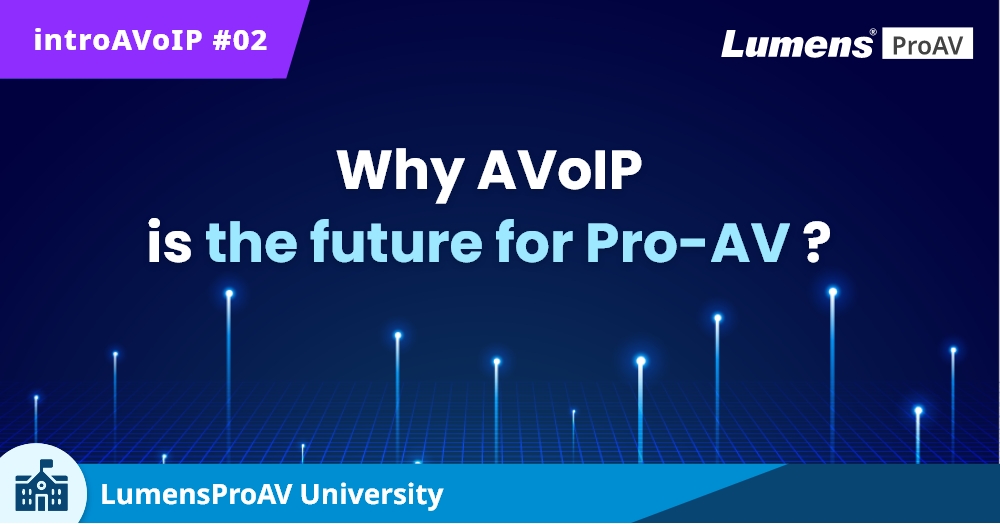【ProAV Lab】introAVoIP#02 - Why AVoIP is the future for Pro-AV?
By Gary Zheng & Kieron Seth, Lumens
June 14, 2022 21863

▶ AVoIP and the distance barrier
There has been a revolution in AV transmission over the last quarter-century. The industry has moved wholesale from analog composite video, S-Video, component video, and VGA connections to digital DVI and HDMI cabling which can deliver lossless video at 4K and even 8K resolution.
But high-resolution video transmission is limited by cable length. At 4K60, standard HDMI cables cannot exceed 3 meters in length. AV installers have no option but to find a work-around, be it optical HDMI cables, conversion to 12G-SDI, or the use of HDMI repeaters. Each is effective, but there’s a cost in terms of capital investment and in terms of system complexity.
▶ Problems on the Horizon
Communication technology is evolving very quickly. According to Nielsen's Law of Internet Bandwidth (similar to Morre's law), bandwidth requirements increase 50% every year. IT networks were once exclusively for file transfer. Today they carry video conferencing calls, Netflix streaming, and a constant flow of photos to social media. The world is increasingly virtual and online: technology needs to evolve rapidly to keep up with the ever-growing demands.
Traditional SDI and AV technologies now seem out of phase; they simply cannot keep up with the demands for ever greater bandwidth.
▶ IP to the Rescue!
IP networking is the answer. Encoding AV signals for transmission over IP networks is the solution. Sending encoded video over data lines instantly opens the potential for long cable runs and considerable cost savings.
Compressing and encoding audio and video is always a trade-off between latency, bandwidth, and image quality. However, in reality, modern encoding algorithms can produce visually lossless video pictures at modest bitrates. The chart below shows the compression ratios required to send video over 1GbE cabling. Even at a compression ratio of 15:1 4K 60 (4:4:4) can look stunning, even on large format displays. There is little compromise required. Over 10GbE or higher networks, even better video quality is possible.
Compression technology is the fast-evolving technology that enables AVoIP. Formats such as JPEG 2000, JPEG XS, H.264, and HEVC are revolutionizing the industry, delivering great-looking video at low latency.
▾Table 1: compression ratio to fitting 1GbE network
| Resolution | Frame Rate | Format | Color Depth | Raw Data (Gbps) | Compression on Ratio #1 |
| 1080P | 60 | 4:2:0 | 8 | 1.5 | 1.875 |
| 1080P | 60 | 4:2:2 | 8 | 2 | 2.5 |
| 1080P | 60 | 4:4:4 | 8 | 3 | 3.75 |
| 4K | 60 | 4:2:0 | 8 | 6 | 7.5 |
| 4K | 60 | 4:2:2 | 8 | 8 | 10 |
| 4K | 60 | 4:4:4 | 8 | 12 | 15 |
#1, based on 1GbE effective bandwidth 800Mbps
▶ Network Cable Lengths
Once encoded, video can now be transmitted over Ethernet cables. As you can see from the table below, even the most affordable Cat 5E 1GbE network wiring can carry 4K video over 100 meters. A 10GbE Cat6A cable transmits multiple streams of very high-quality 4:4:4 video over long distances.
▾Table 2: cable length over Ethernet cabling
| Cabling | 10GbE | 5GbE | 2.5GbE | 1GbE |
| Cat 5E | NA | NA | 100m | 100m |
| Cat 6 | 55m | 100m | 100m | 100m |
| Cat 6A | 100m | 100m | 100m | 100m |
Click here Back to Top ↑